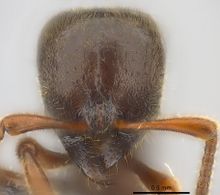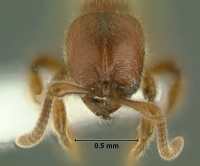Key to Proceratium of the Pacific Oceanic Islands
This worker key is based on: Liu, C., Fischer, G. & Economo, E.P. 2015. A rare ant on Samoa: first record of the cryptic subfamily Proceratiinae and description of a new Proceratium Roger species. Journal of Hymenoptera Research. 46:35-44.
This key does not include New Guinea. You may also be interested in
1
- Dorsal face of petiole node sub-rectangular, almost as wide as long (DPeI 128) (Fig. 1A); mandibles with 4 distinct teeth; body covered with short, dense, decumbent pilosity, longer erect or suberect hairs completely absent; abdominal segment IV strongly recurved (IGR 0.25) (Fig. 1B) (Samoa) . . . . . Proceratium silisili
- Dorsal face of petiole node narrow and transversally compressed, distinctly wider than long (DPeI>150) (Fig. 1C); mandibles with 6 or more teeth or denticles; longer erect or suberect hairs present in addition to short decumbent pilosity; abdominal segment IV distinctly less recurved (IGR 0.46–0.54) (Fig. 1D) . . . . . 2
2
- Subpetiolar process reduced and rounded without any distinct projections (Fig. 2A) (Fiji) . . . . . Proceratium vinaka
- Subpetiolar process not reduced and rounded, either with spiniform or subtriangular / subrectangular lamellate projections (Fig. 2B, C, D) . . . . . 3
3
- Petiole shape in profile squamiform, dorsally distinctly narrower than at the base and anterior face oblique (Fig. 2B, C) . . . . . 4
- Petiole shape in profile flattened subrectangular, at apex not distinctly narrower than at the base and anterior face vertical or subvertical (Fig. 2D) . . . . . 5
4
- Subpetiolar process spiniform (Fiji) (Fig. 2B) . . . . . Proceratium oceanicum
- Subpetiolar process lamellate, subtriangular (Fiji) (Fig. 2C) . . . . . Proceratium relictum
5
- Frontal lobes very small, each lobes’ surface area covering less than clypeal area in between frontal lobes (New Caledonia) (Fig. 3A) . . . . . Proceratium caledonicum
- Frontal lobes larger than clypeal area between frontal lobes (Fig. 3B, C) . . . . . 6
6
- Larger species (HL 0.69–0.74, WL 0.91–1.00); body smooth and shiny, head minutely punctate (New Caledonia) (Figs 3B, 4A) . . . . . Proceratium politum
- Distinctly smaller species (HL 0.55–0.60, WL 0.66–0.70); head and body weakly punctate (Fig. 3C, 4B) (Indonesia, Malaysia, Papua New Guinea, Philippines, Solomon Islands) . . . . . Proceratium papuanum

















